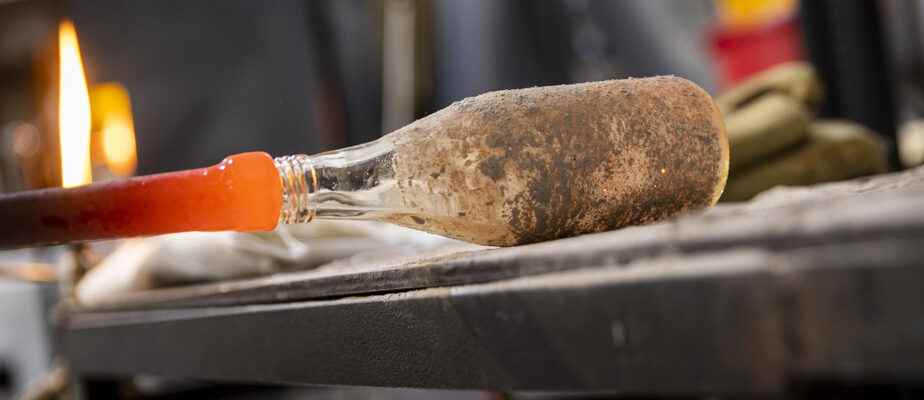Quebec abounds with creators who make original, authentic, unique objects with their hands. The Press meet these craftsmen whose gestures and eyes give color to local design.
Posted at 12:00 p.m.
It’s blisteringly hot near the flaming hearth of the Boutiverre workshop — a 45°C that will redden the skin and make a cup of coffee sweat faster than it was set in anticipation of this appointment. you in the morning with the only recycled glass blower in Quebec. “The body gets used to it”, assures the latter, visibly accustomed to the fires of hell.
On a shelf, glass bottles await their chance to ennoble themselves. Under the intervention of the artist and an extreme treatment, they will be reborn in the form of unique lights that bear the strong and characteristic signature of Boutiverre.
With a confident gesture, Caroline Couture hangs a bottle on the end of her fiery red blowing pipe. The part will be subjected to a temperature of 1200°C. Quickly, the glass deforms, becomes malleable and reforms. The designer, on the lookout for each modification of the material, plunges the object into ashes, sends it back into the flames, cradles it in the air and models it with her breath.
Glassblower Caroline Couture at work
-

PHOTO SARAH MONGEAU-BIRKETT, THE PRESS
Glassblower Caroline Couture at work
-

PHOTO SARAH MONGEAU-BIRKETT, THE PRESS
Glassblower Caroline Couture at work
-

PHOTO SARAH MONGEAU-BIRKETT, THE PRESS
Glassblower Caroline Couture at work
-

PHOTO SARAH MONGEAU-BIRKETT, THE PRESS
Glassblower Caroline Couture at work
1/4
The process includes its share of chance. The result will be revealed once the process is complete. Thus, a mass-produced container will turn into a bumpy, cracked, irregular — unique — luminaire in which light infiltrates in a fascinating way.
It is often said that working with glass is like dancing. You have to know how to adapt to the material. That’s the beauty of glass.
Caroline Couture
“There are less good days when not much good comes out of the oven. It depends if I’m in good shape, if I’m focused, if it’s been a long time since I’ve done a model,” says the founder of Boutiverre. The job, she notes, is physically and mentally demanding. A moment of distraction or relaxation can destroy the work or leave its imprint on the skin.
The fate of each creation is played out in an interval of 5 to 30 minutes during which the creator is in a state of vigilance. The process cannot be interrupted once started. “I have been working with glass for 17 years. Even after all this time, the excitement is still present before each blow, she admits. You have to love adrenaline! »

PHOTO SARAH MONGEAU-BIRKETT, THE PRESS
The globes waiting to be arranged in lights
The meaningful object
“I am quite reckless in life, agrees Caroline Couture. I like to discover and experiment. Reckless, but cautious. Trained in the glass trades after a baccalaureate in education, the craftswoman took years to develop her creations while working full time in a school. Seven years ago, she opened Boutiverre in Lac-Brome, in the Eastern Townships, to devote herself entirely to it three years later.
From the start, her concern for the environment led her to recycled glass. Unlike others, she does not crush it to melt it, but works it into its original form to save more energy. “In my training, we only touch new glass. Normally glassblowers think of a shape and then the steps to make it. Me, I have to think backwards: I start from the bottle and I see what it will allow me to do. It forces you to think differently. »

PHOTO SARAH MONGEAU-BIRKETT, THE PRESS
Some creations
Years of research and practice have allowed him to develop his own techniques to create table objects and mainly the lighting fixtures that have become his hobby over time. “I don’t work with colors, but rather with natural and authentic textures that give a patina to the glass, but go with everything. »
Each piece is dipped during the blowing process: in baking soda to whiten it, in water to retain its clarity while generating cracks, or in ash which oxidizes the glass and deposits shades of white, ocher or blue haphazardly. Boutiverre’s creations have character, and this is the desired effect: a happy encounter between know-how, fire and matter.
-

PHOTO SARAH MONGEAU-BIRKETT, THE PRESS
The Boutiverre workshop-boutique
-

PHOTO SARAH MONGEAU-BIRKETT, THE PRESS
The Boutiverre workshop-boutique
1/2
The notion of professional craftsman is sometimes misunderstood in Quebec, deplores Caroline Couture. “It’s as if there were the artists above and the craftsmen below. What is the difference between the painter and the craftsman? The painter uses his brush and I use the blowing cane. “We sometimes remark to her that she has found a nice hobby or that the price of her creations is high for a lamp or a glass. The fact of working the material with her hands in no way excludes the artistic approach, the knowledge necessary to create and the investment of means, time and money in each creation, she specifies.
Nevertheless, perceptions have changed since the pandemic. “I think people are increasingly looking for objects that have meaning. They are interested in the process, the ethics, the uniqueness of the creation and the person behind it. Being able to sit down with a client to design a light fixture is one of the aspects of the job that Caroline Couture particularly likes. “My lights are handmade, in Quebec, from recycled materials,” she points out. The object has meaning from A to Z.”

